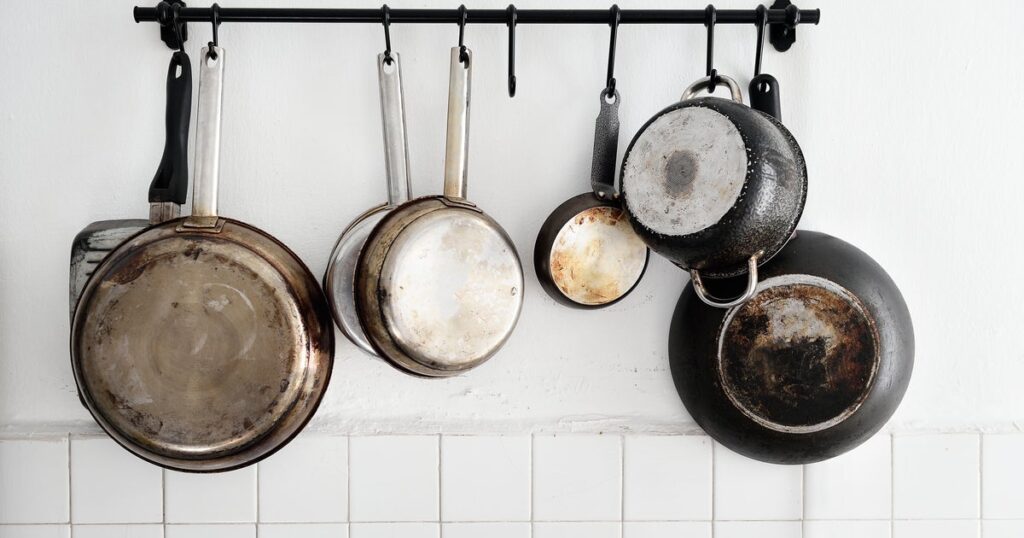We all use cookware, ranging from nonstick pans to copper. But when is it time to replace the pots and pans with something newer that’s not hazardous to our health or will affect the quality of our food?
Daniel Modlin, a former editor at Food & Wine, thinks home cooks shouldn’t spend a lot of money on cookware. “They should invest in the best cookware set they can afford without overspending, based on how often they cook,” he said. “A high-end titanium stainless steel set isn’t necessary for those who cook infrequently. If they have concerns about Teflon, cast iron pans are a great alternative. Watching for sales can help save money, and for those on a tight budget, thrift stores, yard sales, garage sales, Facebook marketplace, and second-hand shops can be an excellent place to find quality cookware at a fraction of the cost.”
He said consumers “should check for warping by placing the pan on a flat surface, avoid scratched or peeling nonstick, and make sure handles are secure.”
Maricel Gentile, chef and owner of Maricel’s Kitchen, a hub for cooking classes, catering and a chef’s table, uses different types of cookware, from long-lasting high-end to more affordable options.
“At home, I tend to invest in higher-end, heavier cookware,” she said. “It might seem counterintuitive, but in a professional kitchen, cookware takes a lot of abuse. It gets dropped, dinged, and dented constantly. Because of that, in my professional kitchen, I focus on getting the best quality possible without overspending.”
She explained that at home, she buys more “decorative” cookware.
“I choose pieces that are not only functional, but also aesthetically pleasing, often selecting designs with artistic elements, matching sets or vibrant colors. At home, I use a mix of titanium stainless steel, some nonstick, cast iron and ceramic.”
Gentile and Modlin broke down the ins and outs of common cookware and when to replace them.
Nonstick (Teflon, Ceramic-Coated, Etc.)
Gentile’s line cooks use stainless, carbon steel, aluminum, and sometimes cast iron cookware. But during her cooking classes, she lets her students use ceramic-coated and nonstick cookware.
“I use cookware in my classes that can be used on induction burners or gas burners,” she said. “I want my students to learn, not fight, with the cookware. A ceramic-coated wok works very well for a beginner versus a carbon-steel wok.” She said this cookware is great for cooking eggs, pancakes and fish. They’re easy to clean, but people should be concerned about Teflon cookware produced before 2013.
Ceramic cookware isn’t made with Teflon and therefore isn’t toxic, so you don’t have to worry about chemicals mixing in with the food.
Gentile said that, according to manufacturers, people should replace their ceramic every two to five years. This, of course, depends on the frequency of usage and the quality of materials. “I find it’s more like one to three years,” she said. “If it’s scratched, peeling, or the coating is wearing off, it’s time to replace it.”
Unlike Teflon, ceramics are non-toxic and free from PTFE (polytetrafluoroethylene) and PFOA (perfluorooctanoic acid) chemicals.
Tetra Images via Getty Images
Copper
Gentile said to replace copper every 10-20 years, but it reacts with acidic foods unless it’s lined.
“If the lining wears off (usually tin or stainless steel), it needs relining or replacing,” Gentile said. The issue is that copper reacts to acid. If it comes in contact with acidic foods, then the copper can leach into the food. Consuming even small bits of copper causes symptoms like diarrhea and nausea. But as long as the non-reactive tin and stainless steel linings stay intact, cooking with copper is safe. Copper is expensive, nice to look at, and offers good heat conductivity, too.
Aluminum
Gentile said to replace it every five to 10 years.
“If heavily scratched, dented or pitted, replace it,” she said. If you cook acidic foods like tomatoes at a high temperature in an aluminum pot, it might leach aluminum into the food. However, everyday exposure to aluminum isn’t seen as a health risk, as the body doesn’t easily absorb the metal. On the safe side, don’t store food in aluminum pans. It’s not always nonstick, but it’s cheap.
What Pans Can Be Recycled?
When cookware has reached its end of life, don’t toss it into the trash. Instead, recycle it. “If they have a nonstick coating, you can’t recycle them. But any other kind of pan can be recycled,” Modlin said. “Most nonstick manufacturers now offer a recycling option for their cookware on their websites, wherein they strip the coating from the pan and then recycle the metal as well.” Companies like GreenPan will recycle old cookware while allowing customers to buy new cookware.
“Some of my best kitchen tools came from second-hand shops, and they outperform cheap, new cookware,” Modlin said. “Save money, cook better, and give great cookware a second life. It’s a win-win!”
Read the full article here








